A story that Max Ammer, the owner of a five-star eco-resort in the Indonesian Papua diver’s paradise of Raja Ampat, loves to tell his guests is about the time he rescued two turtles from a fisherman’s boat in the early nineties.
To continue reading, subscribe to Eco‑Business.
There's something for everyone. We offer a range of subscription plans.
- Access our stories and receive our Insights Weekly newsletter with the free EB Member plan.
- Unlock unlimited access to our content and archive with EB Circle.
- Publish your content with EB Premium.
After buying the turtles from the young fisherman, Ammer immediately put one of them back into the water. Shocked, the boy jumped in after it. He resurfaced without the turtle, but with questions about why his catch had been so carelessly discarded.
As the Dutchman released the second turtle over the side of his boat, he explained to the young fisherman that the animals were worth more alive than dead. From that day, Ammer claims, the boy did not catch another turtle. Instead, Ammer hired him and trained him as a dive instructor at his resort, Papua Diving.
Now, after many years of working there, the former fisherman runs a resort of his own.
“
Preaching the theory of conservation to people doesn’t work. You need to offer them a better way to make money.
Max Ammer, founder, Papua Diving
Only when people see the direct benefits of tourism will they have reason to protect their environment, says Ammer, who counts former shark finners, bomb fishermen and loggers among his 120 staff at his two resorts on the island of Kri, Kri Eco Resort and the more upmarket Sorido Bay, where guests pay about US$2,000 for a week’s stay.
“Preaching the theory of conservation to people doesn’t work. You need to offer them a better way to make money,” he tells Eco-Business during a recent media visit to his resort.
Though West Papua’s economy is growing quickly, fuelled by agribusiness and tourism, local communities—especially indigenous people—have not enjoyed an equal share in that growth, and are Indonesia’s poorest people; Ammer’s mission is to involve local, indigenous communities as his business grows.
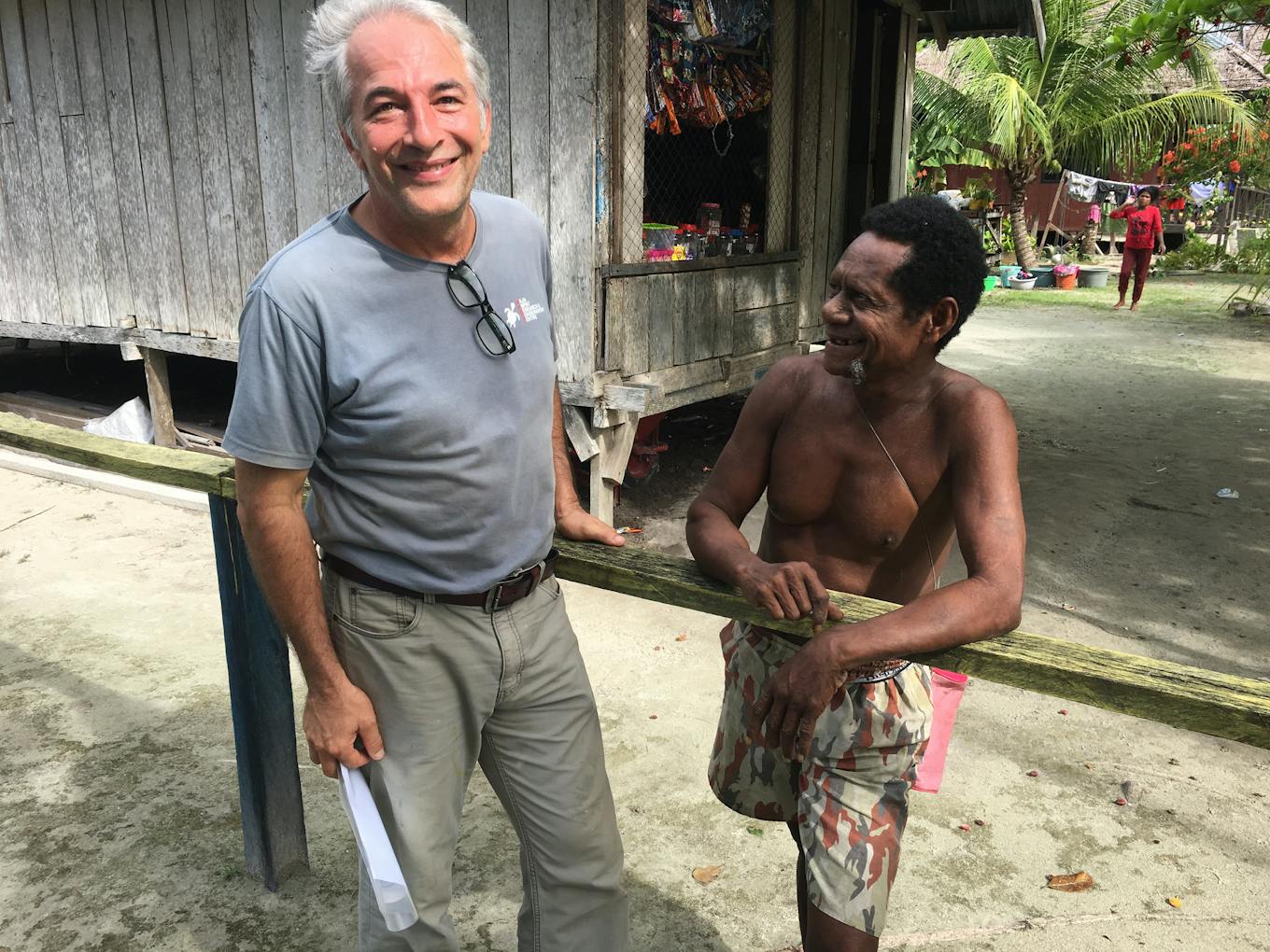
Max Ammer shares a joke with former bomb fisherman Soleiman Dimara of the Biak tribe, Raja Ampat. Image: Eco-Business
Awareness of the need to protect the area is growing among fisherman who eke out a living in the remote province, but it is not always because the sustainability message is hitting home. Eco-Business visited a village that was a 10-minutes boat ride away from Kri Island, where a former bomb fisherman shared that he stopped the practice because he was scared of being put in jail again.
Paradise in peril
Kri Island is nestled in the heart of Raja Ampat Marine Park, an area set up to protect what is claimed to be the world’s most biologically diverse coral habitat, and where 75 per cent of all coral species are known to live.
Raja Ampat, often dubbed ‘the last paradise on earth’, is also home to rare animals unique to the 40,000 square-kilometre region’s jungle-covered islands, such as the inimitable Bird of Paradise.
But Raja Ampat has been the victim of its own natural wealth. Not only have dynamite and poison fishing harmed the reef, vulnerable species such as turtles, sharks, crocodiles and Napoleon wrasse have also been targeted by poachers, threatening the region’s ecological balance.
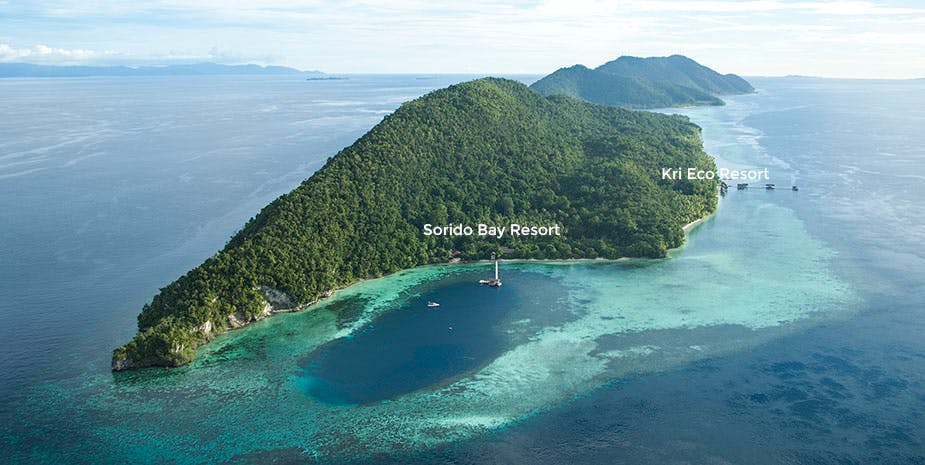
Kri Island, with resorts Sorido Bay and Kri Eco Resort highlighted. Image: Papua-Diving
The biggest threat to the area, says Papuan native Bustar Maitar, a former Greenpeace Indonesia campaigner who now runs environmental consultancy EcoNusa Foundation, is mass tourism.
Relatively untouched until the start of the decade, Raja Ampat is now the poster child for the ‘Wonderful Indonesia’ international tourism campaign. Though expensive for an Indonesian province and relatively hard to get to, it now receives visitors in ever-greater numbers.
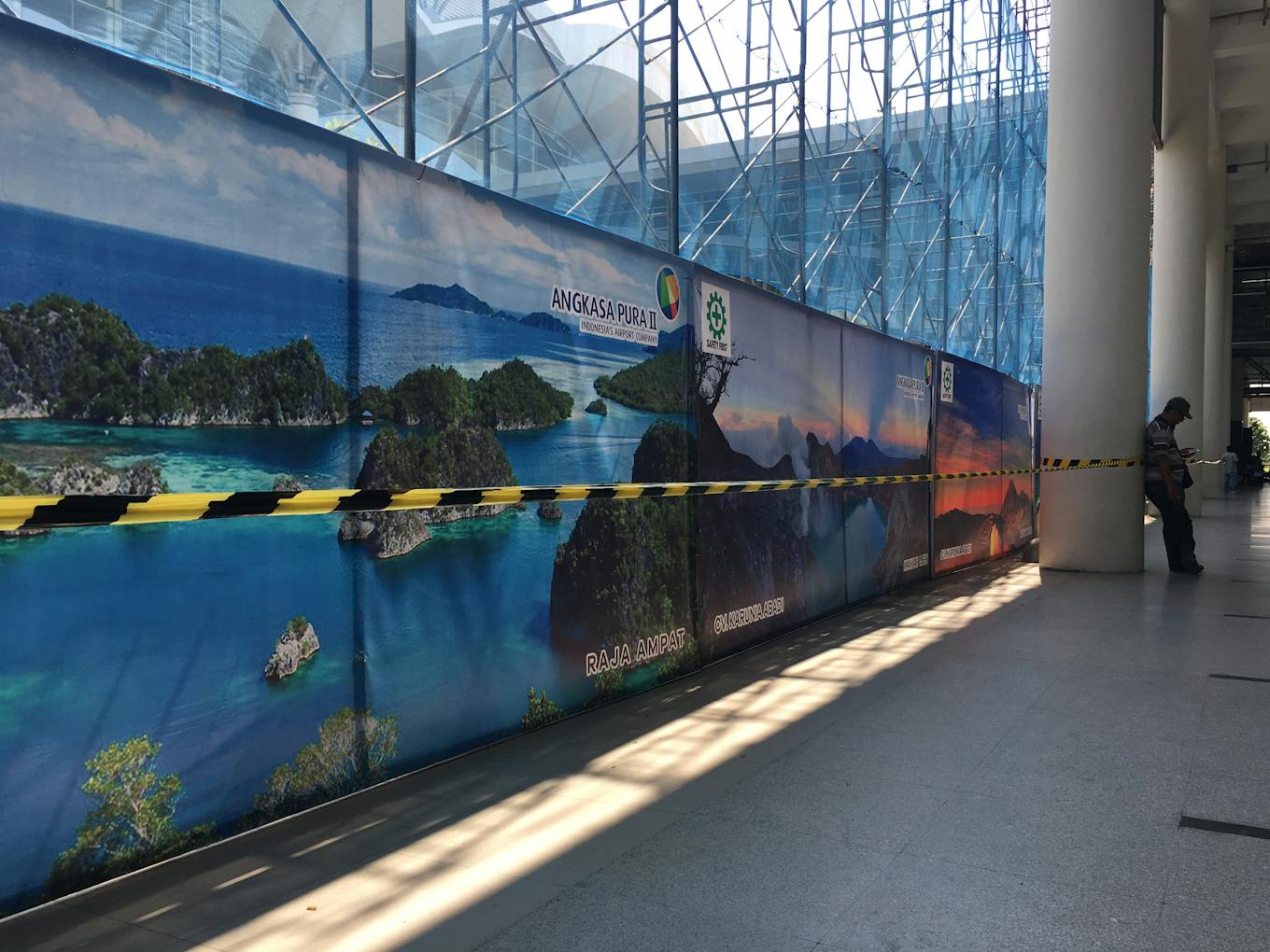
Raja Ampat advertised on a billboard at Kualanamu International Airport, Medan, Indonesia. Image: Eco-Business
A journey from Singapore to Raja Ampat now takes 12 hours, and involves three flights and a boat ride, but an expanded runway at Marinda Airport on the island of Waisai will slash travel time, and make one of the world’s most pristine marine environments more accessible to the masses.
In under a decade, tourism in Raja Ampat has ballooned by more than 1,300 per cent—from just 998 visitors in 2007 to 14,137 in 2015. At this rate, there will be 92,000 tourist arrivals each year by 2021—a number that is, according to Conservation International, more than three times the carrying capacity of Raja Ampat’s dive sites.
The conscientiousness of tourists is another worry, Maitar tells Eco-Business. To access the marine park, visitors must buy an entry permit that supposedly goes towards protecting the reserve and on community development programmes. But many sneak in without buying a pass, and these visitors are less likely to be aware or care about the fragility of the area, he says.
The race to be first
More tourists mean more pressure on Raja Ampat’s most prized asset—its coral reefs. This is a threat that came into sharp focus in May last year, when a 4,200-tonne British cruise ship ran aground and destroyed 14,000 square metres of pristine reef.
Though the incident made international headlines, a bigger and more constant threat to corals is the careless dropping of anchors by liveaboard boats that happens on a daily basis, says Max Ammer, who estimates that on average, 55 liveaboard boats are moored in the archipelago every day.
“Tidal change will make these anchors drag and destroy an area of reef as big as a ship in one day, and that is happening 55 times a day. But no one is doing anything about it,” he says.
Ammer’s idea to confront the problem—to install some 200 buoys for liveaboards to moor to in partnership with the Liveaboard Association so that boats don’t need to drop anchor—is part of the Dutchman’s plan to green his resort and the environment on which his business depends.
He also hopes to set up a marine association to ensure that mooring fees are collected, and the rules are enforced.
One idea is for local communities to own the moorings, and for mooring fees to go towards maintenance of the buoys, which will be managed by locals.
“You have a ship, you can operate here, fine—but pay for the mooring,” says Ammer. “Otherwise the reefs are going to be destroyed.”
For it to work, he needs rival liveaboard operators on side onside. “It is stupid to not work together. We can help each other, at least on things that affect everyone’s interests. Other things we do by ourselves,” he says.
The son of an oil executive, raised surrounded by animals and nature in Nigeria, Ammer founded Papua Diving almost three decades ago after spending a time in West Papua hunting for submerged World War II aircraft, one of his many esoteric passions.
While some visitors may raise eyebrows at two young cassowary birds kept in captivity on the island, and the ritual feeding of Cuscus and black-tip reef sharks for the guests at Sorido Bay, Ammer wants to have the first eco-resort in Raja Ampat that can genuinely call itself green.
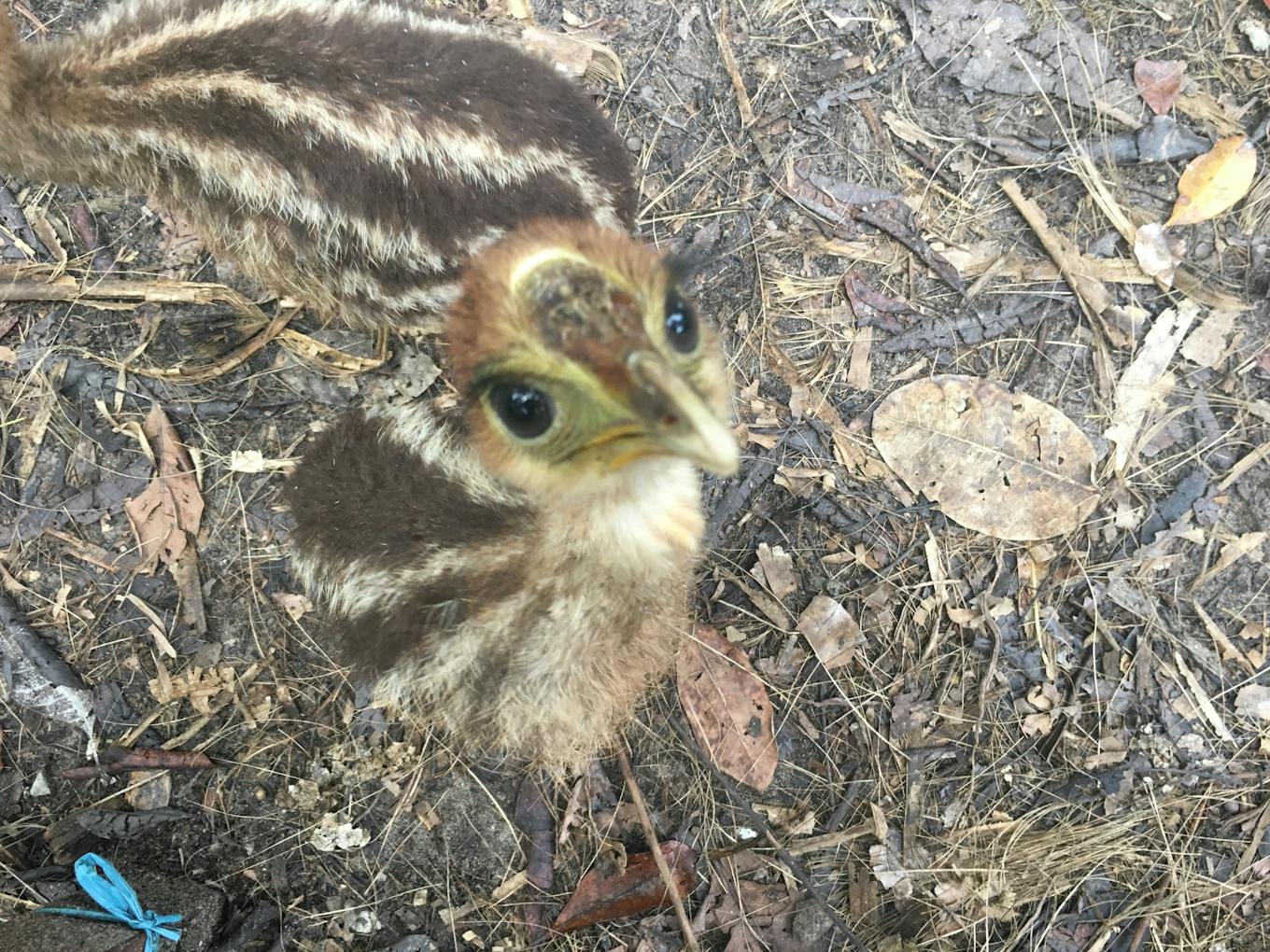
A young cassowary living at Sorido Bay. Image: Eco-Business
While a number of resorts in the area claim to be eco-friendly, most—like Papua Diving—continue to rely on polluting diesel generators for power and import fresh water in plastic bottles. Ammer wants to fix this, and he wants it done quickly—because he has competition.
A feather in Papua Diving’s cap is the Raja Ampat Research and Conservation Centre, a conservation project Ammer founded with Conservation International. But a rival operator on the neighbouring island of Misool also has a well developed conservation project, employs mainly locals, and is also partly solar-powered.
Ammer wants to be the first eco-tourism operator in Raja Ampat that can claim to be 100 per cent renewable-powered. To achieve this feat, he has hired fellow countryman Hans van Mameren, a ship designer who founded renewables firm Energy Renewed last year, to fix the resort’s sustainability credentials from top to bottom.
The plan
The first task on van Mameren’s to-do list is the resort’s fleet of 11 petrol-powered boats, which will all be electrified. Solar panels are to be fitted onto their roofs, batteries installed in their hulls, and they’ll be recharged while docked at the jetty at night.
The boats are a good place to start, since they are “independent energy islands” that can be electrified quickly, says van Mameren, who has 50 years’ experience in the shipping industry. The boats will take about three months to convert; the whole resort could take up to two years to make 100 per cent renewables-powered—a lot sooner, if Ammer gets his way.
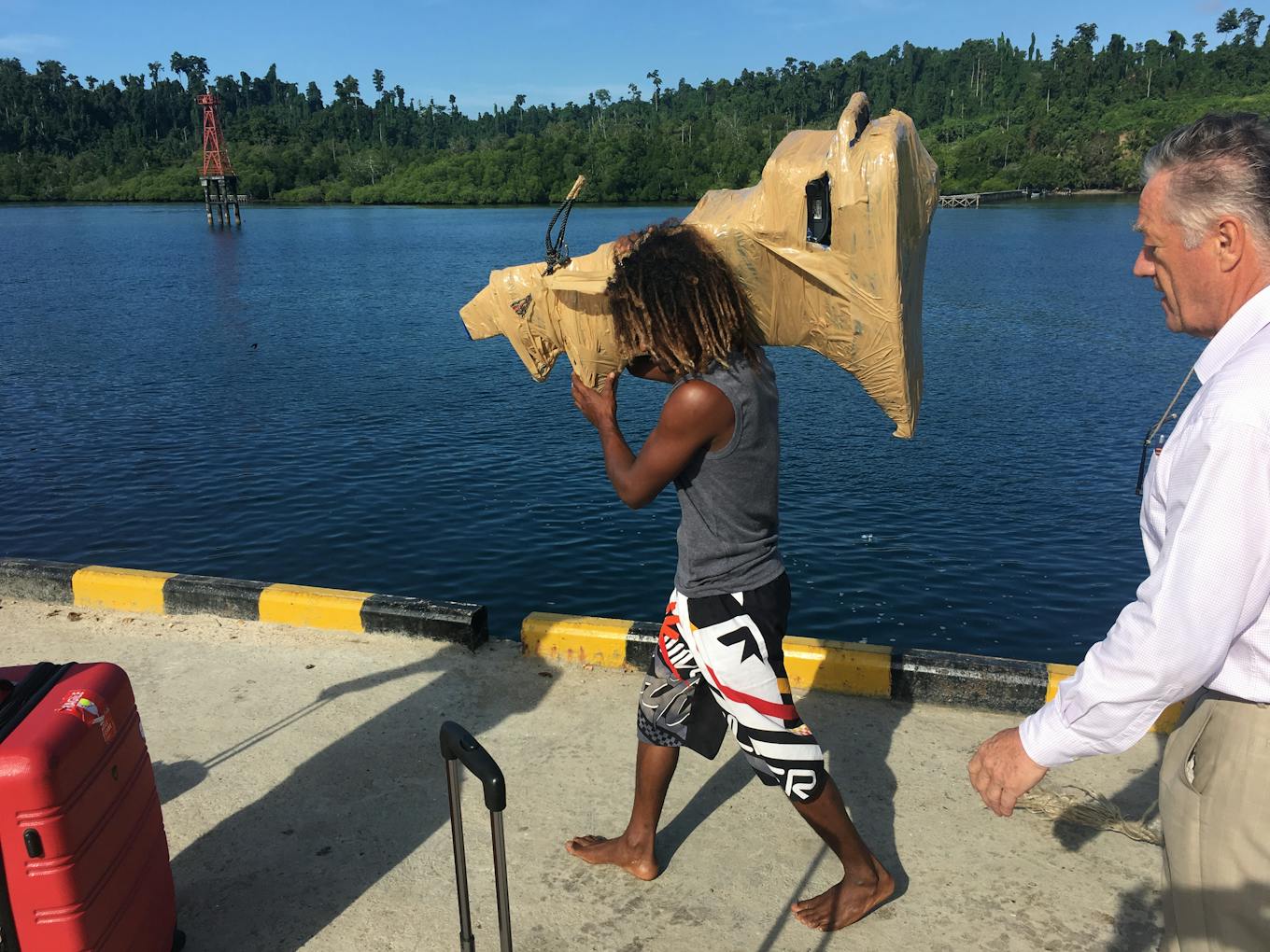
Van Mameren accompanies Frederik Sarwa, a Biak tribesman from Raja Ampat, who is carrying an outboard engine that is to be converted to electric in Singapore. Image: Eco-Business
The next phase is to build small, locally-made electric catamarans that will used to shuttle divers around the dive sites. Two-stroke petrol engines are a serious source of pollution. The exhaust fumes are released underwater, and are slowly polluting the water and reefs. “Fish like clean water as much as we like clean air,” says Van Mameren.
Ferrying divers around in solar-powered boats is not just about bragging rights, he adds. Silent boats cruising around Raja Ampat will not only prompt other dive operators to go electric, but inspire curiosity among the locals.
This principle is central to Ammer’s approach to eco-tourism—build something sustainable using a local workforce, and let that expertise spread through the community.
For instance, Ammer invited local fishermen to learn how to build energy-efficient fibreglass boats, which can now be seen dotted around the area. Some people he has trained in the past are now village leaders, which helps to spread the sustainability message, he says.
Collaborating with locals on sustainability has not always been easy for the plain-speaking Dutchman. In one village in a remote part of Papua, the locals believed him to be a god. In another, he was threatened over a project he wouldn’t support. He also says that bombs have been thrown at him by bomb fishermen that he has turned over to the police.
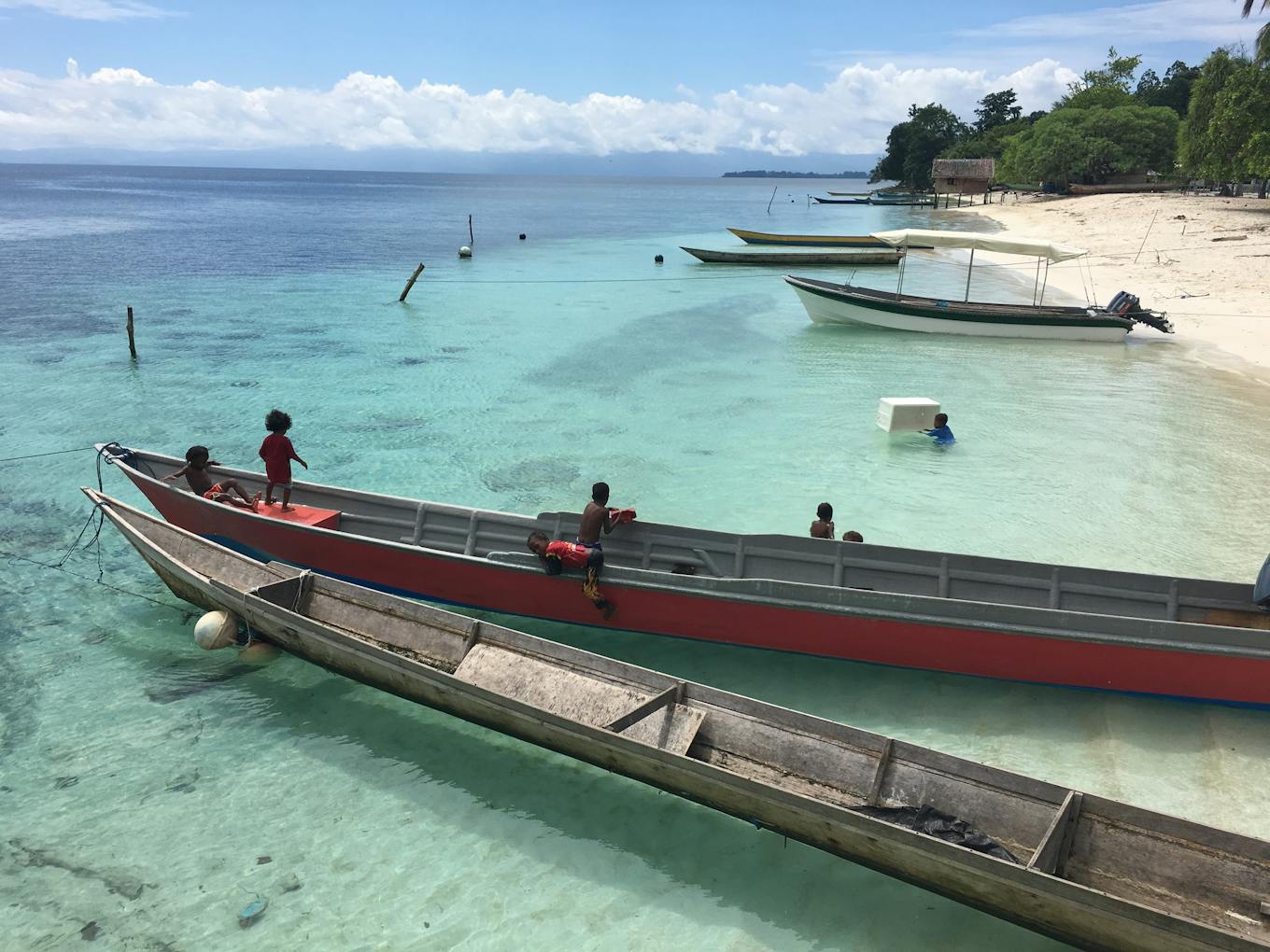
Traditional fishing boats moored on the beach of a village in Raja Ampat. Image: Eco-Business
Solar will be the main source of energy for the two resorts, which take up to 38 guests at a time, adding up to about 1600 clients a year. Air-conditioning in the luxurious guest suites is the biggest energy consumer in the resorts, which are already about 20 per cent powered by solar. But this figure is set to increase as hundreds more panels are to be added to the solar field at Sorido Bay.
Ammer and van Mameren are also exploring tidal power as a source of renewable energy in the resorts. Indonesia’s thousands of islands make one of the world’s strongest cases for tidal power. “The current runs day and night—it’s always there,” says van Mameren. Small tidal turbines are to be trialed just off the shore.

A row of solar panels behind Sorido Bay resort. Image: Eco-Business
But won’t a tidal turbine prove hazardous for fish and other marine creatures? No, because fish can move faster than turbine’s propellor, which moves only as quickly as the current, says van Mameren. “Fish are smart. They will learn to avoid it,” he says.
Once the new renewable energy system is up and running, it should take two to three years to recover the cost of the upfront investment (Papua Diving won’t reveal the total cost of the project). The solar panels and batteries, if kept clean and cool, should last for about 15 to 20 years before they need replacing.
Almost everything, from the fibreglass boats to the tidal turbines, will be built by local workers on Kri Island, where Ammer has a workshop equipped with a vast arsenal of tools and machinery.
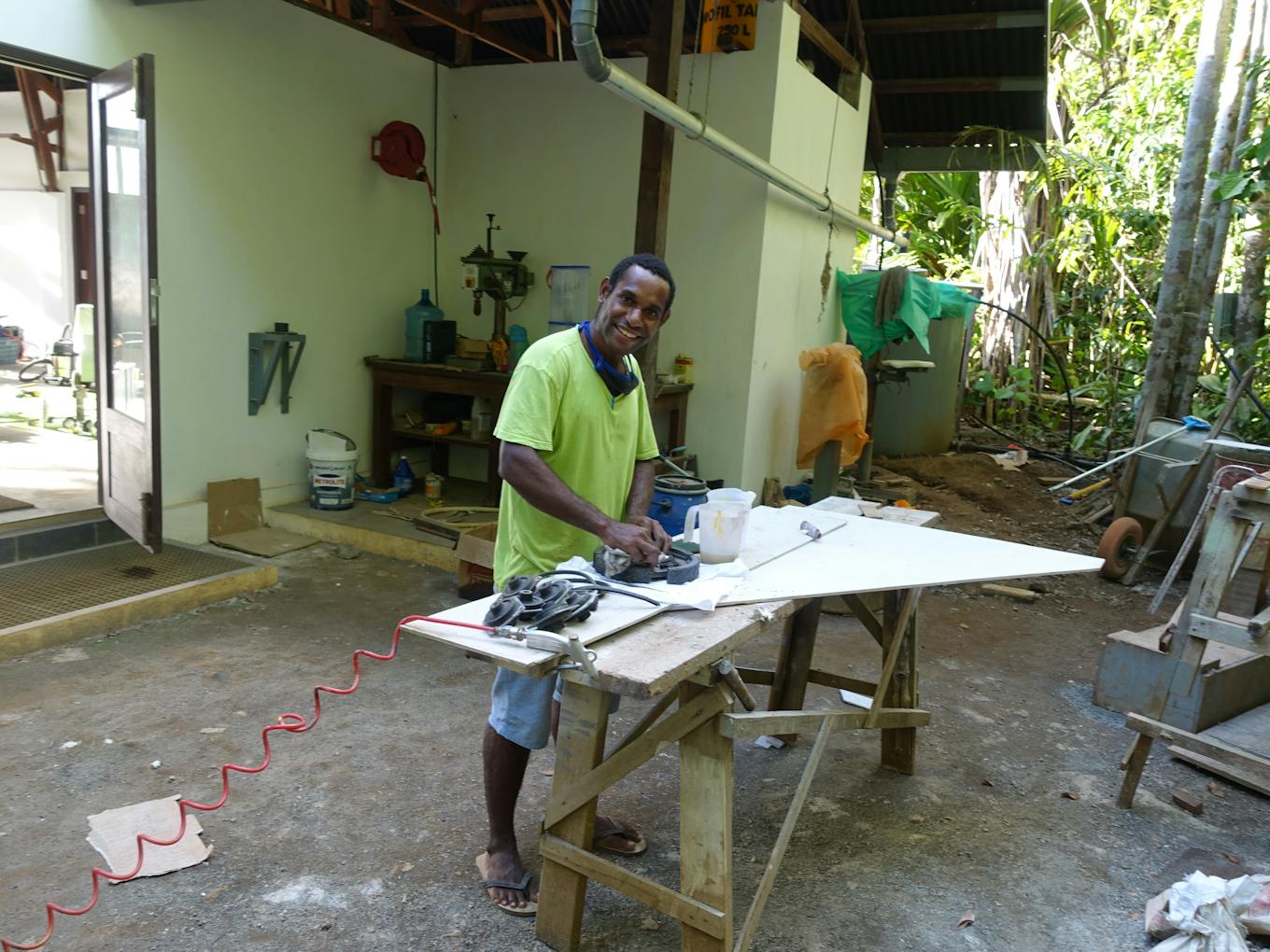
Yali tribesman Malvin Wandik from the Central Highlands is working on the construction of a Bell 47 helicopter to be used for search and rescue operations, and for conservation research. Image: Eco-Business
Water and farming
Ammer also plans to make the island totally water self-sufficient. With no natural water supply, Kri Island currently relies on clean water from the neighbouring city of Sorong, delivered in large plastic bottles.
The two resorts already use some recycled water collected from rain gutters on the roofs of the chalets. That pipe network is to be expanded, and will feed into a 75-cubic metre water storage facility. A new filtration system will eventually mean drinkable tap water—a rarity in Papua.
Water could also be used to irrigate a farm on the island. To date, Ammer has been reluctant to move into agriculture, as he is wary of undermining a revenue stream for the local people from whom he buys food. But a small-scale farm is a possibility, using waste water and kitchen waste as compost.
Plastic in paradise
When it comes to waste management, the resort minimises its own plastic use by serving guests water in glass jugs, and handing out reusable metal water containers as soon as they arrive. But even remote Raja Ampat has not escaped Southeast Asia’s chronic plastic pollution problem.
Divers report seeing drifting plastic trash on almost every dive, and plastic debris can be seen drifting on the surface everywhere from Sorong, the entry city for Raja Ampat, to Kri Island, washing up on the shores of private beaches.
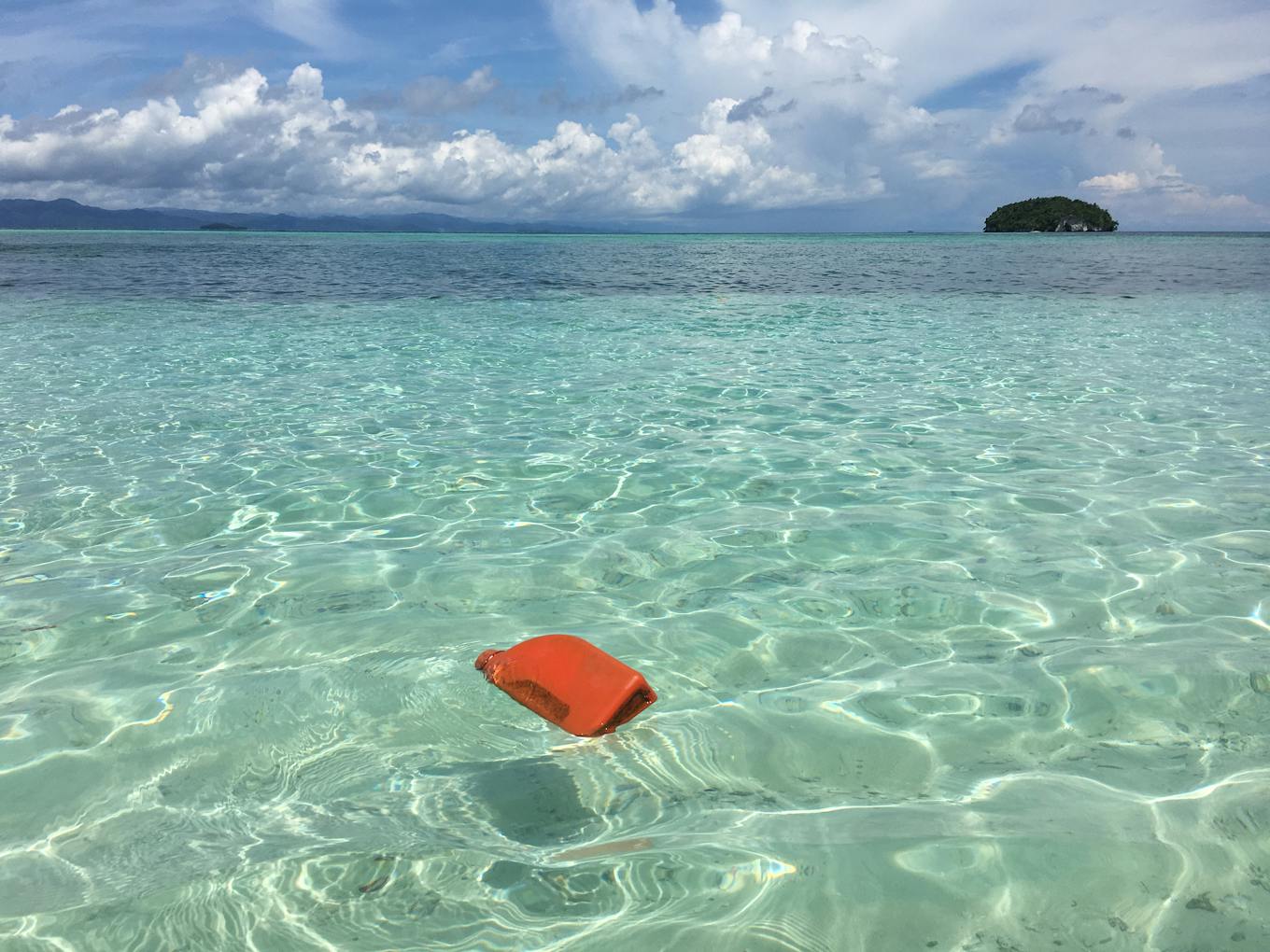
A plastic bottle drifts by the beach of a private villa at Sorido Bay resort. Image: Eco-Business
Though local tour operators claim that the plastic comes from other parts of Indonesia and China, strained garbage collection systems and trash-choked rivers in Sorong visibly contribute to the problem.
The plastic problem is one so big that it seems beyond the pragmatic Ammer, who prides himself on being able to fix things in-house. He says that despite some efforts to tackle the issue by the Indonesian government, they have not been effective.
One idea van Mameren has to contain plastic waste around Kri Island is to place skimmers in shallow coastal waters that work like oil spill booms, trapping drifting surface debris. The main concern, he says, is where to take the collected rubbish.
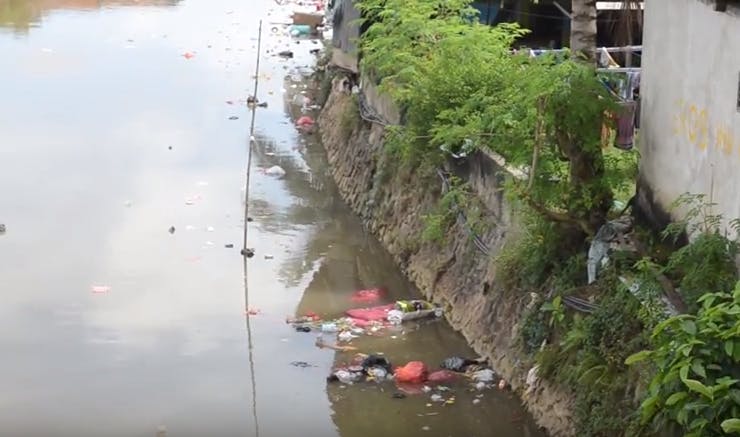
River polluted with plastic garbage in Sorong, West Papua, Indonesia. Image: YouTube/Bank Sampah
Another idea is to work with rival eco resorts in Raja Ampat to collect plastic on their beaches and reefs, and send it to a recycling plant in Sorong. Called Bank Sampah, or waste bank, the plant works like a regular bank. Deposits of plastic are weighed and valued, and customers can earn, save and withdraw from their account. It is a private initiative run by Misool Resort and run by a small team of volunteers.
Once the system for collecting and transporting the plastic waste is up and running, the plan is to plug local villages into the network. Currently, most villages lack any sort of formal rubbish collection system.
A model for the future of Papua
Ammer’s grand plan is to copy and paste his sustainable eco-resort model to other parts of Papua, which he says will help local communities that have not yet been included in Indonesia’s economic growth story.
He points to the rapid expansion of the palm oil industry in the interior of Papua as just one way that indigenous Papuans have been left behind by development in the region, while their neighbours across the border in Papua New Guinea enjoy far higher living standards.
“Some indigenous people should be millionaires after selling their land [to agribusiness firms],” he says. “But they don’t know how to negotiate, and they don’t understand the value of money, so they end up selling their land for next to nothing.”
Ammer wants to include Papua’s indigenous people in the growth of his business, as he branches out from diving to other forms of nature tourism. He plans to build small resorts of luxurious eco-lodges in Papua’s cool, mountainous interior. There, guests can immerse themselves in nature and go hiking.
But for his plan to work, he cannot do it alone. Collaboration is key, he says, even in Papua’s competitive tourism sector. He uses the example of a Canadian gold miner who could not find the gold vein he was looking for. So he placed all his geological data on the internet, and asked users for their advice. A year later he hit the vein and became a billionaire.
The same thing applies to ecotourism, says Ammer. “Some people keep everything to themselves, and they don’t share. But you can win more from sharing than you lose from not sharing.”




